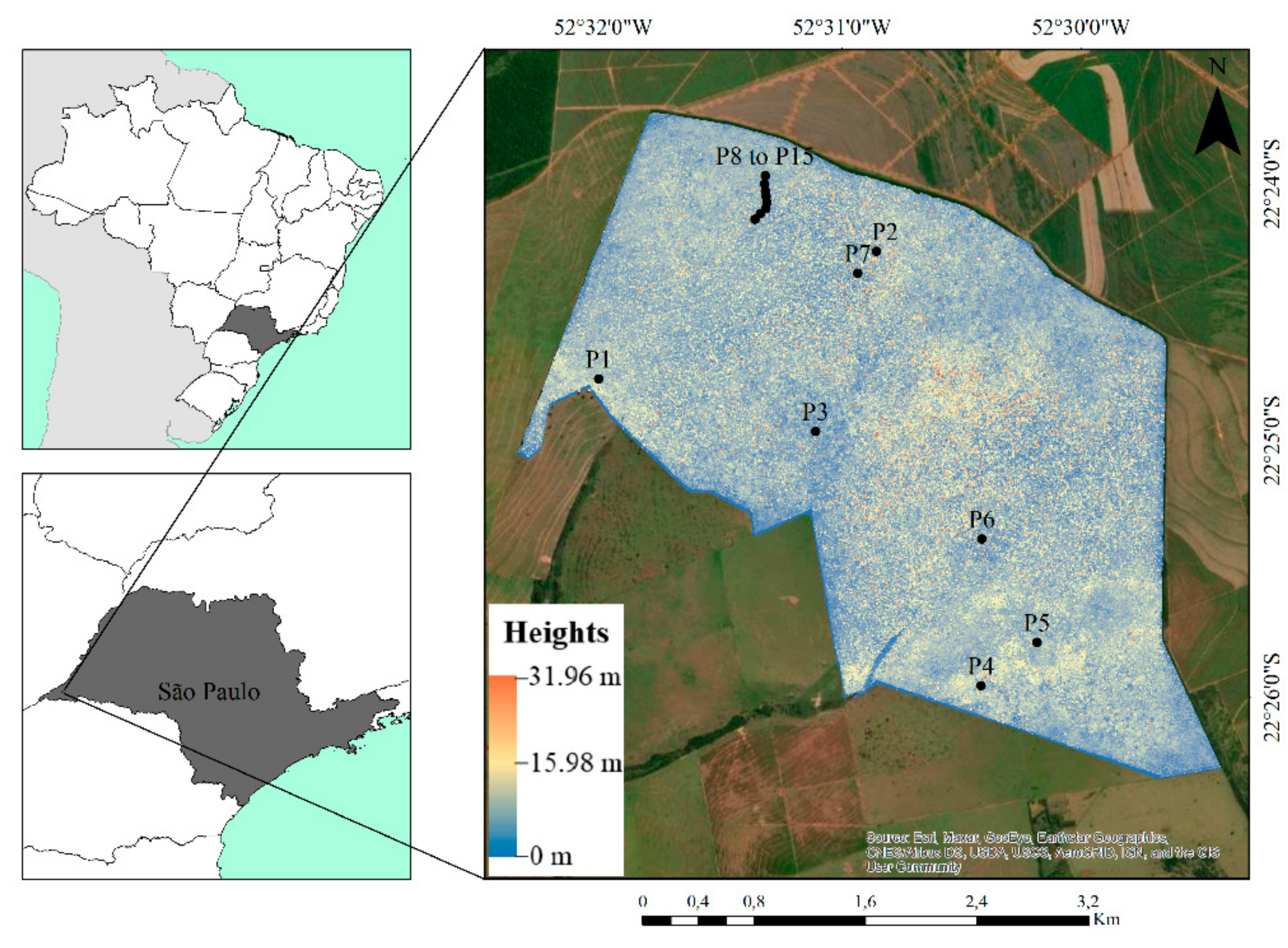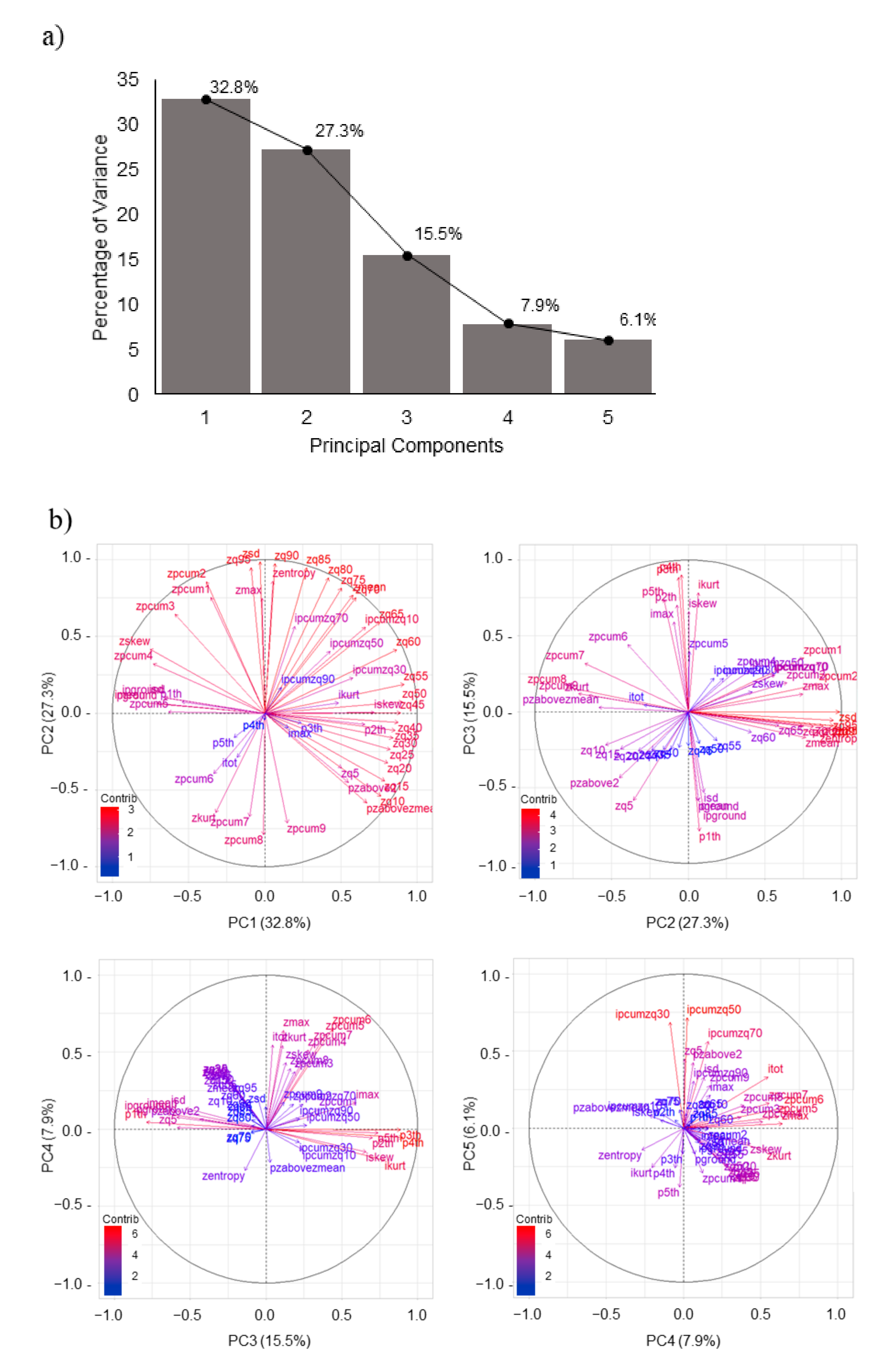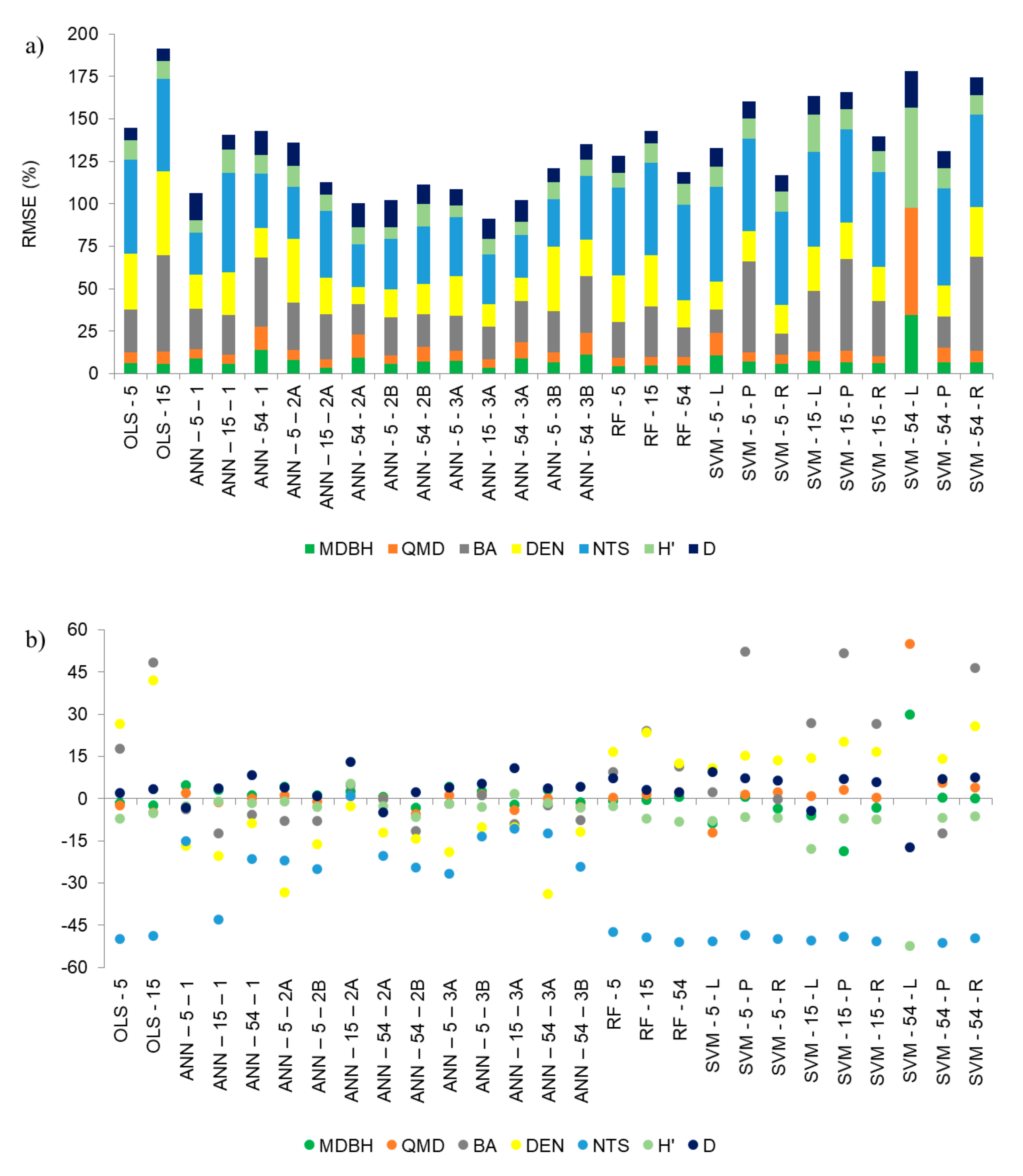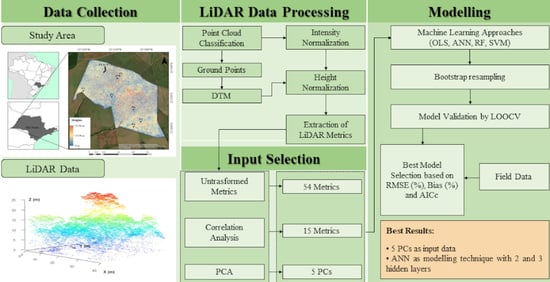Identification of Significative LiDAR Metrics and Comparison of Machine Learning Approaches for Estimating Stand and Diversity Variables in Heterogeneous Brazilian Atlantic Forest
Abstract
:1. Introduction
2. Materials and Methods
2.1. Field Survey
2.2. LiDAR Data Collection
2.3. LiDAR Data Processing
2.4. Input Data Selection
2.5. Regression Techniques Settings
2.6. Evaluation and Performance of Tested Models
3. Results
3.1. Correlation Analysis and PCAs
3.2. Model Performance and Evaluation
3.3. Importance of Input Metrics
4. Discussion
5. Conclusions
Supplementary Materials
Author Contributions
Funding
Institutional Review Board Statement
Informed Consent Statement
Data Availability Statement
Acknowledgments
Conflicts of Interest
Abbreviations
| ALS | Airborne Laser Scanner |
| AGB | Aboveground Biomass |
| AIC | Akaike Information Criterion |
| AICc | Corrected Akaike Information Criteria |
| ANN | Artificial Neural Network |
| BA | Basal Area |
| CMH | Canopy Height Model |
| D | Simpson diversity index |
| DBH | Diameter at breast height |
| DEN | Density |
| DTM | Digital Terrain Model |
| H’ | Shannon–Waver diversity index |
| LiDAR | Light Detection and Ranging |
| LOOCV | Leave–one -out cross–validation |
| MDBH | Mean diameter at breast height |
| NTS | Number of tree species |
| OLS | Ordinary least–squares multiple regression |
| PC | Principal Component |
| PCA | Principal Component Analysis |
| QMD | Quadratic mean diameter |
| RF | Random Forest |
| RMSE | Root Mean Square Error |
| SVM | Support Vector Machine |
| ε–SVM | Epsilon Support Vector Machine |
| TIN | Triangular Irregular Network |
References
- De Souza Werneck, M.; Sobral, M.E.G.; Rocha, C.T.V.; Landau, E.C.; Stehmann, J.R. Distribution and Endemism of Angiosperms in the Atlantic Forest. Nat. Conserv. 2011, 9, 188–193. [Google Scholar] [CrossRef]
- Hopkins, M.J. Modelling the Known and Unknown Plant Biodiversity of the Amazon Basin. J. Biogeogr. 2007, 34, 1400–1411. [Google Scholar] [CrossRef]
- Nogueira, E.M.; Nelson, B.W.; Fearnside, P.M. Volume and Biomass of Trees in Central Amazonia: Influence of Irregularly Shaped and Hollow Trunks. For. Ecol. Manag. 2006, 227, 14–21. [Google Scholar] [CrossRef]
- Nogueira, E.M.; Fearnside, P.M.; Nelson, B.W.; Barbosa, R.I.; Keizer, E.W.H. Estimates of Forest Biomass in the Brazilian Amazon: New Allometric Equations and Adjustments to Biomass from Wood-Volume Inventories. For. Ecol. Manag. 2008, 256, 1853–1867. [Google Scholar] [CrossRef]
- Yao, W.; Krull, J.; Krzystek, P.; Heurich, M. Sensitivity Analysis of 3D Individual Tree Detection from LiDAR Point Clouds of Temperate Forests. Forests 2014, 5, 1122–1142. [Google Scholar] [CrossRef] [Green Version]
- Shan, J.; Toth, C.K. Topographic Laser Ranging and Scanning: Principles and Processing; CRC Press: Boca Raton, FL, USA, 2018. [Google Scholar]
- Miltiadou, M.; Agapiou, A.; Gonzalez Aracil, S.; Hadjimitsis, D.G. Detecting Dead Standing Eucalypt Trees from Voxelised Full-Waveform Lidar Using Multi-Scale 3D-Windows for Tackling Height and Size Variations. Forests 2020, 11, 161. [Google Scholar] [CrossRef] [Green Version]
- Falkowski, M.J.; Evans, J.S.; Martinuzzi, S.; Gessler, P.E.; Hudak, A.T. Characterizing Forest Succession with Lidar Data: An Evaluation for the Inland Northwest, USA. Remote Sens. Environ. 2009, 113, 946–956. [Google Scholar] [CrossRef] [Green Version]
- Næsset, E. Effects of Different Flying Altitudes on Biophysical Stand Properties Estimated from Canopy Height and Density Measured with a Small-Footprint Airborne Scanning Laser. Remote Sens. Environ. 2004, 91, 243–255. [Google Scholar] [CrossRef]
- Donoghue, D.N.; Watt, P.J.; Cox, N.J.; Wilson, J. Remote Sensing of Species Mixtures in Conifer Plantations Using LiDAR Height and Intensity Data. Remote Sens. Environ. 2007, 110, 509–522. [Google Scholar] [CrossRef]
- Morsdorf, F.; Frey, O.; Meier, E.; Itten, K.I.; Allgöwer, B. Assessment of the Influence of Flying Altitude and Scan Angle on Biophysical Vegetation Products Derived from Airborne Laser Scanning. Int. J. Remote Sens. 2008, 29, 1387–1406. [Google Scholar] [CrossRef]
- García-Gutiérrez, J.; Martínez-Álvarez, F.; Troncoso, A.; Riquelme, J.C. A Comparison of Machine Learning Regression Techniques for LiDAR-Derived Estimation of Forest Variables. Neurocomputing 2015, 167, 24–31. [Google Scholar] [CrossRef]
- Da Silva, V.S.; Silva, C.A.; Mohan, M.; Cardil, A.; Rex, F.E.; Loureiro, G.H.; de Almeida, D.R.A.; Broadbent, E.N.; Gorgens, E.B.; Dalla Corte, A.P. Combined Impact of Sample Size and Modeling Approaches for Predicting Stem Volume in Eucalyptus Spp. Forest Plantations Using Field and LiDAR Data. Remote Sens. 2020, 12, 1438. [Google Scholar] [CrossRef]
- Zhao, K.; Popescu, S.; Meng, X.; Pang, Y.; Agca, M. Characterizing Forest Canopy Structure with Lidar Composite Metrics and Machine Learning. Remote Sens. Environ. 2011, 115, 1978–1996. [Google Scholar] [CrossRef]
- Venier, L.A.; Swystun, T.; Mazerolle, M.J.; Kreutzweiser, D.P.; Wainio-Keizer, K.L.; McIlwrick, K.A.; Woods, M.E.; Wang, X. Modelling Vegetation Understory Cover Using LiDAR Metrics. PLoS ONE 2019, 14, e0220096. [Google Scholar] [CrossRef] [PubMed] [Green Version]
- Silva, C.A.; Klauberg, C.; Hudak, A.T.; Vierling, L.A.; Jaafar, W.S.W.M.; Mohan, M.; Garcia, M.; Ferraz, A.; Cardil, A.; Saatchi, S. Predicting Stem Total and Assortment Volumes in an Industrial Pinus taeda L. Forest Plantation Using Airborne Laser Scanning Data and Random Forest. Forests 2017, 8, 254. [Google Scholar] [CrossRef] [Green Version]
- Görgens, E.B.; Montaghi, A.; Rodriguez, L.C.E. A Performance Comparison of Machine Learning Methods to Estimate the Fast-Growing Forest Plantation Yield Based on Laser Scanning Metrics. Comput. Electron. Agric. 2015, 116, 221–227. [Google Scholar] [CrossRef]
- Schikowski, A.B.; Corte, A.P.; Ruza, M.S.; Sanquetta, C.R.; Montano, R.A. Modeling of Stem Form and Volume through Machine Learning. Anais Acad. Bras. Ciências 2018, 90, 3389–3401. [Google Scholar] [CrossRef]
- Rex, F.E.; Silva, C.A.; Dalla Corte, A.P.; Klauberg, C.; Mohan, M.; Cardil, A.; da Silva, V.S.; de Almeida, D.R.A.; Garcia, M.; Broadbent, E.N. Comparison of Statistical Modelling Approaches for Estimating Tropical Forest Aboveground Biomass Stock and Reporting Their Changes in Low-Intensity Logging Areas Using Multi-Temporal LiDAR Data. Remote Sens. 2020, 12, 1498. [Google Scholar] [CrossRef]
- Fiaschi, P.; Pirani, J.R. Review of Plant Biogeographic Studies in Brazil. J. Syst. Evol. 2009, 47, 477–496. [Google Scholar] [CrossRef]
- Hargreaves, P. Phytosociology in Brazil. J. Plant. Sci. Biotechnol. 2008, 2, 12–20. [Google Scholar]
- Ribeiro, M.C.; Metzger, J.P.; Martensen, A.C.; Ponzoni, F.J.; Hirota, M.M. The Brazilian Atlantic Forest: How Much Is Left, and How Is the Remaining Forest Distributed? Implications for Conservation. Biol. Conserv. 2009, 142, 1141–1153. [Google Scholar] [CrossRef]
- Haddad, N.M.; Brudvig, L.A.; Clobert, J.; Davies, K.F.; Gonzalez, A.; Holt, R.D.; Lovejoy, T.E.; Sexton, J.O.; Austin, M.P.; Collins, C.D. Habitat Fragmentation and Its Lasting Impact on Earth’s Ecosystems. Sci. Adv. 2015, 1, e1500052. [Google Scholar] [CrossRef] [Green Version]
- Myers, N.; Mittermeier, R.A.; Mittermeier, C.G.; Da Fonseca, G.A.; Kent, J. Biodiversity Hotspots for Conservation Priorities. Nature 2000, 403, 853. [Google Scholar] [CrossRef]
- Williams, K.J.; Ford, A.; Rosauer, D.F.; de Silva, N.; Mittermeier, R.; Bruce, C.; Larsen, F.W.; Margules, C. Forests of East Australia: The 35th biodiversity hotspot. In Biodiversity Hotspots; Springer: Berlin/Heidelberg, Germany, 2011; pp. 295–310. [Google Scholar]
- IBGE. Manual Técnico Da Vegetação Brasileira, 2nd ed.; Manuais Técnicos em Geociências; IBGE: Rio de Janeiro, Brazil, 2012; ISBN 978-85-240-4272-0. [Google Scholar]
- MMA; IBAMA; ICMBio. Plano de Manejo Da Estação Ecológica Mico-Leão-Preto; ICMBio: Brasilia, Brazil, 2007. [Google Scholar]
- Yu, X.; Hyyppä, J.; Vastaranta, M.; Holopainen, M.; Viitala, R. Predicting Individual Tree Attributes from Airborne Laser Point Clouds Based on the Random Forests Technique. ISPRS J. Photogramm. Remote Sens. 2011, 66, 28–37. [Google Scholar] [CrossRef]
- Hyyppä, J.; Yu, X.; Hyyppä, H.; Vastaranta, M.; Holopainen, M.; Kukko, A.; Kaartinen, H.; Jaakkola, A.; Vaaja, M.; Koskinen, J. Advances in Forest Inventory Using Airborne Laser Scanning. Remote Sens. 2012, 4, 1190–1207. [Google Scholar] [CrossRef] [Green Version]
- Berveglieri, A.; Tommaselli, A.M.G.; Imai, N.N.; Ribeiro, E.A.W.; Guimaraes, R.B.; Honkavaara, E. Identification of Successional Stages and Cover Changes of Tropical Forest Based on Digital Surface Model Analysis. IEEE J. Sel. Top. Appl. Earth Obs. Remote Sens. 2016, 9, 5385–5397. [Google Scholar] [CrossRef]
- Berveglieri, A.; Imai, N.N.; Tommaselli, A.M.; Casagrande, B.; Honkavaara, E. Successional Stages and Their Evolution in Tropical Forests Using Multi-Temporal Photogrammetric Surface Models and Superpixels. ISPRS J. Photogramm. Remote Sens. 2018, 146, 548–558. [Google Scholar] [CrossRef]
- Magurran, A.E. Ecological Diversity and Its Measurement; Princeton University Press: Princeton, NJ, USA, 1988. [Google Scholar]
- Brower, J.E.; Zar, J.H.; Von Ende, C.A. Field and Laboratory Methods for General Ecology; Brown Publishers: Dubuque, IA, USA, 1984. [Google Scholar]
- ASPRS. Las Specification Version 1.3—R11 2010; ASPRS: Bethesda, MD, USA, 2010. [Google Scholar]
- RIEGL. DataSheet LMS-Q680i; RIEGL: Horn, Austria, 2012. [Google Scholar]
- Isenburg, M. LAStools-Efficient LiDAR Processing Software. Available online: lastools.org (accessed on 24 May 2021).
- R Core Team. R: A Language and Environment for Statistical Computing; R Foundation for Statistical Computing: Vienna, Austria, 2017. [Google Scholar]
- Roussel, J.-R.; Auty, D.; de Boissieu, F.; Meador, A.S. LidR: Airborne LiDAR Data Manipulation and Visualization for Forestry Applications. R Package Version 2018, 1, 1. [Google Scholar]
- Ahokas, E.; Kaasalainen, S.; Hyyppä, J.; Suomalainen, J. Calibration of the Optech ALTM 3100 Laser Scanner Intensity Data Using Brightness Targets. Int. Arch. Photogramm. Remote Sens. Spat. Inf. Sci. 2006, 36, 1–6. [Google Scholar]
- Hopkinson, C. The Influence of Flying Altitude, Beam Divergence, and Pulse Repetition Frequency on Laser Pulse Return Intensity and Canopy Frequency Distribution. Can. J. Remote Sens. 2007, 33, 312–324. [Google Scholar] [CrossRef]
- Kaasalainen, S.; Hyyppä, J.; Litkey, P.; Hyyppä, H.; Ahokas, E.; Kukko, A.; Kaartinen, H. Radiometric Calibration of ALS Intensity. Int. Arch. Photogramm. Remote Sens. 2007, 36, 201–205. [Google Scholar]
- Roussel, J.-R.; Bourdon, J.-F.; Achim, A. Range-Based Intensity Normalization of ALS Data over Forested Areas Using a Sensor Tracking Method from Multiple Returns. Earth ArXiv 2020. [Google Scholar] [CrossRef]
- Gatziolis, D. Dynamic Range-Based Intensity Normalization for Airborne, Discrete Return Lidar Data of Forest Canopies. Photogramm. Eng. Remote Sens. 2011, 77, 251–259. [Google Scholar] [CrossRef]
- Luo, S.; Chen, J.M.; Wang, C.; Gonsamo, A.; Xi, X.; Lin, Y.; Qian, M.; Peng, D.; Nie, S.; Qin, H. Comparative Performances of Airborne LiDAR Height and Intensity Data for Leaf Area Index Estimation. IEEE J. Sel. Top. Appl. Earth Observ. Remote Sens. 2017, 11, 300–310. [Google Scholar] [CrossRef]
- Shi, Y.; Wang, T.; Skidmore, A.K.; Heurich, M. Important LiDAR Metrics for Discriminating Forest Tree Species in Central Europe. ISPRS J. Photogramm. Remote Sens. 2018, 137, 163–174. [Google Scholar] [CrossRef]
- Sumnall, M.J.; Hill, R.A.; Hinsley, S.A. Comparison of Small-Footprint Discrete Return and Full Waveform Airborne LiDAR Data for Estimating Multiple Forest Variables. Remote Sens. Environ. 2016, 173, 214–223. [Google Scholar] [CrossRef] [Green Version]
- Zhang, Z.; Liu, X. Support Vector Machines for Tree Species Identification Using LiDAR-Derived Structure and Intensity Variables. Geocarto Int. 2013, 28, 364–378. [Google Scholar] [CrossRef]
- Khosravipour, A.; Skidmore, A.K.; Isenburg, M.; Wang, T.; Hussin, Y.A. Generating Pit-Free Canopy Height Models from Airborne Lidar. Photogramm. Eng. Remote Sens. 2014, 80, 863–872. [Google Scholar] [CrossRef]
- Hudak, A.T.; Strand, E.K.; Vierling, L.A.; Byrne, J.C.; Eitel, J.U.; Martinuzzi, S.; Falkowski, M.J. Quantifying Aboveground Forest Carbon Pools and Fluxes from Repeat LiDAR Surveys. Remote Sens. Environ. 2012, 123, 25–40. [Google Scholar] [CrossRef] [Green Version]
- Silva, C.A.; Klauberg, C.; e Carvalho, S.d.P.C.; Hudak, A.T. Mapping Aboveground Carbon Stocks Using LiDAR Data in Eucalyptus Spp. Plantations in the State of São Paulo, Brazil. Sci. Forestalis 2014, 42, 591–604. [Google Scholar]
- Manly, B.F.; Alberto, J.A.N. Multivariate Statistical Methods: A Primer; CRC Press: Boca Raton, NJ, USA, 2016. [Google Scholar]
- Abdi, H.; Williams, L.J. Principal Component Analysis. Wiley Interdiscip. Rev. Comput. Stat. 2010, 2, 433–459. [Google Scholar] [CrossRef]
- Lê, S.; Josse, J.; Husson, F. FactoMineR: An R Package for Multivariate Analysis. Stat. Softw. 2008, 25, 1–18. [Google Scholar]
- Kaiser, H.F. The Varimax Criterion for Analytic Rotation in Factor Analysis. Psychometrika 1958, 23, 187–200. [Google Scholar] [CrossRef]
- Cliff, N. The Eigenvalues-Greater-than-One Rule and the Reliability of Components. Psychol. Bull. 1988, 103, 276. [Google Scholar] [CrossRef]
- Hongyu, K.; Sandanielo, V.L.M.; de Oliveira Junior, G.J. Análise de Componentes Principais: Resumo Teórico, Aplicação e Interpretação. E&S Eng. Sci. 2016, 5, 83–90. [Google Scholar] [CrossRef] [Green Version]
- Carvalho, A.; Faceli, K.; Lorena, A.; Gama, J. Inteligência Artificial-Uma Abordagem de Aprendizado de Máquina; LTC: Rio de Janeiro, Brazil, 2011. [Google Scholar]
- Freese, F. Linear Regression Methods for Forest Research; US Department of Agriculture, Forest Service, Forest Products Laboratory: Washington, DC, USA, 1964; Volume 17. [Google Scholar]
- Kuhn, M. Building Predictive Models in R Using the Caret Package. J. Stat. Softw. 2008, 28, 1–26. [Google Scholar] [CrossRef] [Green Version]
- Lumley, T.; Lumley, M.T. Package ‘Leaps’. Regression Subset Selection. Thomas Lumley Based on Fortran Code by Alan Miller. Available online: http://CRAN.R-project.org/package=leaps (accessed on 18 March 2018).
- Shin, J.; Temesgen, H.; Strunk, J.L.; Hilker, T. Comparing Modeling Methods for Predicting Forest Attributes Using LiDAR Metrics and Ground Measurements. Can. J. Remote Sens. 2016, 42, 739–765. [Google Scholar] [CrossRef]
- Haykin, S. Neural Networks and Learning Machines, 3/E; Pearson Education India: Chennai, India, 2010. [Google Scholar]
- Hornik, K.; Stinchcombe, M.; White, H. Multilayer Feedforward Networks Are Universal Approximators. Neural Netw. 1989, 2, 359–366. [Google Scholar] [CrossRef]
- Günther, F.; Fritsch, S. Neuralnet: Training of Neural Networks. R. J. 2010, 2, 30–38. [Google Scholar] [CrossRef] [Green Version]
- Shibata, K.; Ikeda, Y. Effect of Number of Hidden Neurons on Learning in Large-Scale Layered Neural Networks. In Proceedings of the 2009 ICCAS-SICE; IEEE: Piscataway, NJ, USA, 2009; pp. 5008–5013. [Google Scholar]
- Breiman, L. Random Forests, Machine Learning 45. J. Clin. Microbiol. 2001, 2, 199–228. [Google Scholar]
- Berk, R.A. Statistical Learning from a Regression Perspective; Springer: New York, NY, USA, 2008; Volume 14. [Google Scholar]
- Liaw, A.; Wiener, M. Classification and Regression by RandomForest. R News 2002, 2, 18–22. [Google Scholar]
- Cortes, C.; Vapnik, V. Support-Vector Networks. Mach. Learn. 1995, 20, 273–297. [Google Scholar] [CrossRef]
- Huang, C.; Davis, L.S.; Townshend, J.R.G. An Assessment of Support Vector Machines for Land Cover Classification. Int. J. Remote Sens. 2002, 23, 725–749. [Google Scholar] [CrossRef]
- Ben-Hur, A.; Weston, J. A user’s guide to support vector machines. In Data Mining Techniques for the Life Sciences; Humana Press: Totowa, NJ, USA, 2010; pp. 223–239. [Google Scholar]
- Karatzoglou, A.; Smola, A.; Hornik, K.; Zeileis, A. Kernlab-an S4 Package for Kernel Methods in R. J. Stat. Softw. 2004, 11, 1–20. [Google Scholar] [CrossRef] [Green Version]
- Meyer, D.; Dimitriadou, E.; Hornik, K.; Weingeesel, A.; Leisch, F. E1071: Misc Functions of the Department of Statistics (E1071), TU Wien. R Package Version 1.6-1. 2012. Available online: https://www.researchgate.net/publication/221678005_E1071_Misc_Functions_of_the_Department_of_Statistics_E1071_TU_Wien (accessed on 24 May 2021).
- Latifi, H.; Fassnacht, F.; Koch, B. Forest Structure Modeling with Combined Airborne Hyperspectral and LiDAR Data. Remote Sens. Environ. 2012, 121, 10–25. [Google Scholar] [CrossRef]
- Akaike, H. A New Look at the Statistical Model Identification. IEEE Trans. Autom. Control. 1974, 19, 716–723. [Google Scholar] [CrossRef]
- Bozdogan, H. Model Selection and Akaike’s Information Criterion (AIC): The General Theory and Its Analytical Extensions. Psychometrika 1987, 52, 345–370. [Google Scholar] [CrossRef]
- Mohammed, A.A.; Naugler, C.; Far, B.H. Emerging Business Intelligence Framework for a Clinical Laboratory through Big Data Analytics. In Emerging Trends in Computational Biology, Bioinformatics, and Systems Biology: Algorithms and Software Tools; Elsevier/Morgan Kaufmann: New York, NY, USA, 2015; pp. 577–602. [Google Scholar] [CrossRef]
- Hurvich, C.M.; Tsai, C.-L. Regression and Time Series Model Selection in Small Samples. Biometrika 1989, 76, 297–307. [Google Scholar] [CrossRef]
- McQuarrie, A.D.; Tsai, C.-L. Regression and Time Series Model. Selection; World Scientific: Singapore, 1998. [Google Scholar]
- Næsset, E. Practical Large-Scale Forest Stand Inventory Using a Small-Footprint Airborne Scanning Laser. Scand. J. For. Res. 2004, 19, 164–179. [Google Scholar] [CrossRef]
- Chiarello, F.; Steiner, M.T.A.; Oliveira, E.B.D.; Arce, J.E.; Ferreira, J.C. Artificial Neural Networks Applied in Forest Biometrics and Modeling: State of the Art (January/2007 to July/2018). Cerne 2019, 25, 140–155. [Google Scholar] [CrossRef]
- Reis, L.P.; de Souza, A.L.; Mazzei, L.; dos Reis, P.C.M.; Leite, H.G.; Soares, C.P.B.; Torres, C.M.M.E.; da Silva, L.F.; Ruschel, A.R. Prognosis on the Diameter of Individual Trees on the Eastern Region of the Amazon Using Artificial Neural Networks. For. Ecol. Manag. 2016, 382, 161–167. [Google Scholar] [CrossRef]
- Reis, L.P.; de Souza, A.L.; dos Reis Reis, P.C.M.; Mazzei, L.; Binoti, D.H.B.; Leite, H.G. Prognose Da Distribuição Diamétrica Na Amazônia Utilizando Redes Neurais Artificiais e Autômatos Celulares. Floresta 2018, 48, 93–102. [Google Scholar] [CrossRef]
- Da Rocha, S.J.S.S.; Torres, C.M.M.E.; Jacovine, L.A.G.; Leite, H.G.; Gelcer, E.M.; Neves, K.M.; Schettini, B.L.S.; Villanova, P.H.; da Silva, L.F.; Reis, L.P. Artificial Neural Networks: Modeling Tree Survival and Mortality in the Atlantic Forest Biome in Brazil. Sci. Total Environ. 2018, 645, 655–661. [Google Scholar] [CrossRef]
- Gorgens, E.B.; Leite, H.G.; Gleriani, J.M.; Soares, C.P.B.; Ceolin, A. Influência Da Arquitetura Na Estimativa de Volume de Árvores Individuais Por Meio de Redes Neurais Artificiais. Revista Árvore 2014, 38, 289–295. [Google Scholar] [CrossRef] [Green Version]
- Panchal, G.; Ganatra, A.; Kosta, Y.P.; Panchal, D. Behaviour Analysis of Multilayer Perceptrons with Multiple Hidden Neurons and Hidden Layers. Int. J. Comput. Theory Eng. 2011, 3, 332–337. [Google Scholar] [CrossRef] [Green Version]
- Dumitru, C.; Maria, V. Advantages and Disadvantages of Using Neural Networks for Predictions. Ovidius Univ. Ann. Ser. Econ. Sci. 2013, 13, 444–449. [Google Scholar]
- Niska, H.; Skon, J.-P.; Packalen, P.; Tokola, T.; Maltamo, M.; Kolehmainen, M. Neural Networks for the Prediction of Species-Specific Plot Volumes Using Airborne Laser Scanning and Aerial Photographs. IEEE Trans. Geosci. Remote Sens. 2009, 48, 1076–1085. [Google Scholar] [CrossRef]
- Brosofske, K.D.; Froese, R.E.; Falkowski, M.J.; Banskota, A. A Review of Methods for Mapping and Prediction of Inventory Attributes for Operational Forest Management. For. Sci. 2014, 60, 733–756. [Google Scholar] [CrossRef]
- Næsset, E. Predicting Forest Stand Characteristics with Airborne Scanning Laser Using a Practical Two-Stage Procedure and Field Data. Remote Sens. Environ. 2002, 80, 88–99. [Google Scholar] [CrossRef]
- Monnet, J.-M.; Chanussot, J.; Berger, F. Support Vector Regression for the Estimation of Forest Stand Parameters Using Airborne Laser Scanning. IEEE Geosci. Remote Sens. Lett. 2011, 8, 580–584. [Google Scholar] [CrossRef] [Green Version]
- Woods, M.; Lim, K.; Treitz, P. Predicting Forest Stand Variables from LIDAR Data in the Great Lakes St. Lawrence Forest of Ontario. For. Chron. 2008, 84, 827–839. [Google Scholar] [CrossRef] [Green Version]
- Vincent, G.; Sabatier, D.; Blanc, L.; Chave, J.; Weissenbacher, E.; Pélissier, R.; Fonty, E.; Molino, J.-F.; Couteron, P. Accuracy of Small Footprint Airborne LiDAR in Its Predictions of Tropical Moist Forest Stand Structure. Remote Sens. Environ. 2012, 125, 23–33. [Google Scholar] [CrossRef]






| Field Variables | Minimum | Maximum | Mean | Standard Deviation | Coefficient of Variation (%) 1 |
|---|---|---|---|---|---|
| MDBH | 8.5 | 13.9 | 10.6 | 1.4 | 13.4 |
| QMD | 9.8 | 18.8 | 13.2 | 2.3 | 17.4 |
| BA | 5.6 | 30.7 | 16.2 | 7.5 | 46.2 |
| DEN | 380 | 2286 | 1193 | 569.4 | 47.7 |
| NTS | 10 | 24 | 15 | 3.8 | 25.9 |
| H’ | 1.18 | 2.04 | 1.56 | 0.21 | 13.6 |
| D | 0.49 | 0.79 | 0.67 | 0.08 | 11.9 |
| Metrics | Description |
|---|---|
| ZMAX | Maximum height |
| ZMEAN | Mean height |
| ZSD | Standard deviation of height distribution |
| ZSKEW | Skewness of height distribution |
| ZKURT | Kurtosis of height distribution |
| ZENTROPY | Entropy of height distribution |
| PZABOVEZMEAN | Percentage of returns above ZMEAN |
| PZABOVE2 | Percentage of returns above 2 m |
| ZQx | Xth percentile (5, 10, 15, 20, 25, 30, 35, 40, 45, 50, 55, 60, 65, 70, 75, 80, 85, 90, 95) of height distribution |
| ZPCUMx | Cumulative percentage of return in the Xth layer (1 to 9) with f(z) the probability distribution of elevations |
| ITOT | Sum of intensities for each return |
| IMAX | Maximum intensity |
| IMEAN | Mean intensity |
| ISD | Standard deviation of intensity |
| ISKEW | Skewness of intensity distribution |
| IKURT | Kurtosis of intensity distribution |
| IPGROUND | Percentage of intensity returned by points classified as ground |
| IPCUMZQx | Percentage of intensity returned below the Xth (10, 30, 50, 70, 90) percentile of height |
| PXth | Percentage of Xth returns (1 to 5) |
| PGROUND | Percentage of returns classified as ground |
| Number of Hidden Layers | Inputs | Architecture * | Name |
|---|---|---|---|
| 1 | 5 PCs | 5–3–1 | ANN–5–1 |
| 15 Metrics | 15–4–1 | ANN–15–1 | |
| 54 Metrics | 54–8-1 | ANN–54–1 | |
| 2A | 5 PCs | 5–16–8–1 | ANN–5–2A |
| 15 Metrics | 15–16–8–1 | ANN–15–2A | |
| 54 Metrics | 54–16–8–1 | ANN–54–2A | |
| 2B | 5 PCs | 5–6–3–1 | ANN–5–2B |
| 54 Metrics | 54–55–28–1 | ANN–54–2B | |
| 3A | 5 PCs | 5–16–8–4–1 | ANN–5–3A |
| 15 Metrics | 15–16–8–4–1 | ANN–15–3A | |
| 54 Metrics | 54–16–8–4–1 | ANN–54–3A | |
| 3B | 5 PCs | 5–6–3–1–1 | ANN–5–3B |
| 54 Metrics | 54–55–28–14–1 | ANN–54–3B |
| Kernel Type | Inputs | Name |
|---|---|---|
| Linear | 5 PCs | SVM–5–L |
| 15 Metrics | SVM–15–L | |
| 54 Metrics | SVM–54–L | |
| Polynomial | 5 PCs | SVM–5–P |
| 15 Metrics | SVM–15–P | |
| 54 Metrics | SVM–54–P | |
| Radial | 5 PCs | SVM–5–R |
| 15 Metrics | SVM–15–R | |
| 54 Metrics | SVM–54–R |
| Variables | RMSE (%) | Bias (%) | AICc | Best Model Fitted |
|---|---|---|---|---|
| MDBH | 5.6 | 0.60 | 15.03 | ANN–5–2B |
| QMD | 5.2 | −0.03 | 14.44 | ANN–5–2B |
| BA | 22.5 | −0.24 | 9.33 | ANN–5–2B |
| DEN | 16.3 | −12.31 | −6.75 | ANN–5–2B |
| NTS | 27.6 | −12.49 | 4.90 | ANN–5–3B |
| H’ | 10 | −1.75 | 20.11 | ANN–5–3B |
| D | 8.4 | 3.64 | 24.55 | ANN–5–3B |
Publisher’s Note: MDPI stays neutral with regard to jurisdictional claims in published maps and institutional affiliations. |
© 2021 by the authors. Licensee MDPI, Basel, Switzerland. This article is an open access article distributed under the terms and conditions of the Creative Commons Attribution (CC BY) license (https://creativecommons.org/licenses/by/4.0/).
Share and Cite
Martins-Neto, R.P.; Tommaselli, A.M.G.; Imai, N.N.; David, H.C.; Miltiadou, M.; Honkavaara, E. Identification of Significative LiDAR Metrics and Comparison of Machine Learning Approaches for Estimating Stand and Diversity Variables in Heterogeneous Brazilian Atlantic Forest. Remote Sens. 2021, 13, 2444. https://doi.org/10.3390/rs13132444
Martins-Neto RP, Tommaselli AMG, Imai NN, David HC, Miltiadou M, Honkavaara E. Identification of Significative LiDAR Metrics and Comparison of Machine Learning Approaches for Estimating Stand and Diversity Variables in Heterogeneous Brazilian Atlantic Forest. Remote Sensing. 2021; 13(13):2444. https://doi.org/10.3390/rs13132444
Chicago/Turabian StyleMartins-Neto, Rorai Pereira, Antonio Maria Garcia Tommaselli, Nilton Nobuhiro Imai, Hassan Camil David, Milto Miltiadou, and Eija Honkavaara. 2021. "Identification of Significative LiDAR Metrics and Comparison of Machine Learning Approaches for Estimating Stand and Diversity Variables in Heterogeneous Brazilian Atlantic Forest" Remote Sensing 13, no. 13: 2444. https://doi.org/10.3390/rs13132444
APA StyleMartins-Neto, R. P., Tommaselli, A. M. G., Imai, N. N., David, H. C., Miltiadou, M., & Honkavaara, E. (2021). Identification of Significative LiDAR Metrics and Comparison of Machine Learning Approaches for Estimating Stand and Diversity Variables in Heterogeneous Brazilian Atlantic Forest. Remote Sensing, 13(13), 2444. https://doi.org/10.3390/rs13132444









